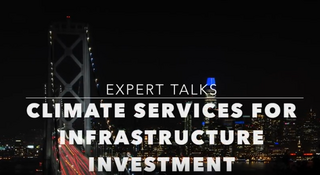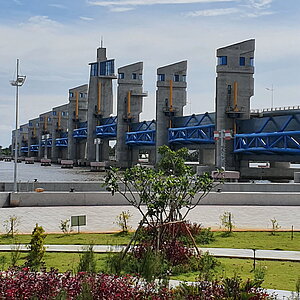Costa Rica’s hands-on (climate action) policy

In Costa Rica, tropical storms regularly cause serious damage to the country’s infrastructure. IKI supports the country in becoming more climate resilient.
One morning in November 2020… Costa Rica’s National Emergency Commission (CNE) has just published a new online map showing city districts in the country’s capital, San José. The Coronavirus Map resembles an orange-and-yellow mosaic. While this update isn’t welcomed by Iván Delgado, Nazareth Rojas, Vladimir Naranjo and María Ramírez, it’s entirely expected: most of the districts marked in orange are where their homes and offices are located. These four experts, who work in the country’s ministries and government agencies, will not be able to meet in person. Instead, they are greeted by a video call from Federico Corrales, a GIZ worker who is based in Costa Rica. One by one, all of her colleagues appear in little boxes onscreen, swapping greetings and jokes about the real or fantastical screen backgrounds they are currently using. Then they quickly get down to business: the ‘Grupo Herramienta Tica’ (literally the ‘Costa Rican Tool Group’) has been working on a method for analysing climate risks.
Extreme weather events are becoming more frequent and more violent
When the five experts first met in 2017 and 2018, the working group didn’t even exist. The Covid-19 pandemic was still far over the horizon and the media was focused instead on the devastation wreaked by Hurricane Otto, followed by Hurricane Nate. Since weather records began, this marked the first time that storms not only reached the coastline of Costa Rica but made landfall, criss-crossing the Central American country and causing widespread, severe damage. Even though ‘Nate’ lasted only a few hours, the scale of destruction was immense, causing damage estimated at almost USD 600 million—roughly one percent of Costa Rica’s GDP. Public infrastructure was hit hard, with roads, streets and bridges some of the worst-affected areas. Jobs were lost and income levels collapsed—even in the informal sector—with poorer and more rural parts of the population suffering the most.
Storms make adopting national adaptation plan a top priority
At the same time (in 2018), the Costa Rican Ministry of Environment, Energy and Telecommunications (MINAE) was making every effort to finalise its National Adaptation Plan (NAP). The recent hurricanes had also placed adaptation to climate change at the top of the political agenda once again. Following the celebrated signing of the Paris Agreement at the 2015 UN Climate Change Conference, Costa Rica made substantial progress towards emissions mitigation. The country achieved international recognition not only for its efforts—99 percent of its electricity is generated from renewables and creates no emissions—but also as a spokesperson and advocate for climate action targets.
As Climate Change Adaptation Officer in the Climate Change Directorate, Ivan Delgado also participated in the drafting of the NAP. At the same time, he was also involved in the ‘Improved Climate Services for Infrastructure Investments (CSI)’ project, which was financed via International Climate Initiative (IKI). In 2017, the CSI project had selected the La Guardia Bridge in the country’s northwestern Guanacaste Province as the target for a climate risk analysis, to be conducted with a number of public and private partners. The bridge had been damaged regularly by flooding even before the two major hurricane events and its demolition seemed likely.

Climate risk assessment produced by interdisciplinary expert group
While working on the risk assessment for the bridge, Delgado also met the leading members of the later interdisciplinary ‘Herramienta Tica’ group: Nazareth Rojas from the National Meteorological Institute, María Ramirez, Head of Dept. at the Ministry of Public Works and Transport and Vladimir Naranjo, Head of Dept. at the Costa Rican Association of Engineers and Architects (CFIA). The team completed a number of on-the-job training sessions and contributed their various expertise to the IKI project.
For the bridge risk assessment work, for example, data on past extreme weather events as well as projections were required only if they had adversely affected infrastructure components in the past or were expected to do so in the future. The experts then calculated the ‘threshold values’ for various infrastructure components. These included the maximum thermostability of the road surface, the highest wind speeds the bridge piers were capable of withstanding and the volume of torrential rain that would lead to bridge flooding.
When aligned with the infrastructure in this way, the climate data provided insights into the risks of the past, present and—in particular—the future. This interdisciplinary process provided an opportunity for Ivan Delgado to include ‘climate-proofing’ formulations, intended to protect infrastructure from the impacts of climate change, into the final wording of the country’s National Adaptation Plan.
Comptroller General pushes planning for resilient infrastructure
Before the final reports on the La Guardia bridge were published, other representatives of national and academic institutions were invited to advise on the reports’ findings, methods and the novel interdisciplinary approach. A central role was played here by the ‘Contraloría General de la República’, Costa Rica’s Comptroller General. The Comptroller General’s Office was quick to seize the initiative here, castigating the bridge’s high costs in terms of damage claims, closure and reconstruction—and the grave effects on the national economy.
The climate risk assessment concluded that the bridge should not yet be demolished. Apart from increasing its overall height, badly affected bridge components should be replaced or renovated in 2021. This would avoid the steep costs of new bridge construction, which could be postponed for about 30 years.
Adjusting the risk assessment to the needs of Costa Rica
With additional climate risk assessments now being planned for existing infrastructure, the working group subsequently turned its focus to the question of how best to adapt the Canadian PIEVC assessment protocol to the needs of Costa Rica. The goal here was to improve the methods used for existing infrastructure and new infrastructure yet to be planned. This methodology would then become mandatory for future infrastructure planning processes.
At the same time, the Comptroller General—successfully—pressurised the government to make climate-resilient a central plank of policy: Costa Rica’s President Alvarado Quesada subsequently invited the Environment and Transport ministries, the Meteorological Institute and the National Emergency Commission to help draft and prepare a presidential decree on the topic of climate-resilient infrastructure.
Milestones for the IKI project
Almost one year after the consultation period, President Alvarado Quesada signed the decree for climate-resilient public infrastructure in June 2020. This achieves several IKI project milestones, the first of which being the successful field-testing of the National Adaptation Plan in terms of climate-resilient infrastructure. Simultaneously, the Ministry of the Environment also established collaborative structures—with the Ministry for Transport, for example. Last but not least, the National Meteorological Institute also developed some key climate services for the project that can expand its core business in the future.
The project illustrates the interplay between the formulation of policy frameworks and pilot-driven implementation, and not only documents a willingness to accept change on the part of Costa Rica but shows how achieving coherence between policy formulation and implementation is an iterative rather than linear process. To build on their achievements in this process, the ‘Grupo Herramienta Tica’ continues to meet every two weeks—just as on this morning in November 2020—to work on the institutionalising of the Costa Rican methods toolbox with the aim of putting the President’s decree into practice. And to establish climate risk assessments as an integral part of infrastructure planning. Apart from Covid-19, their virtual meeting is later overshadowed by another warning: Hurricane Eta is heading towards Costa Rica.
The link has been copied to the clipboard
Contact
IKI Office
Zukunft – Umwelt – Gesellschaft (ZUG) gGmbH
Stresemannstraße 69-71
10963 Berlin
Further information
Interview with Andrea Meza Murillo, Minister of the Environment in Costa Rica
Interactive overview of the "Climate Services for Infrastructure Investments" project


















